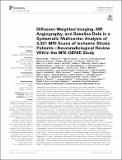Diffusion-Weighted Imaging, MR Angiography, and Baseline Data in a Systematic Multicenter Analysis of 3,301 MRI Scans of Ischemic Stroke Patients—Neuroradiological Review Within the MRI-GENIE Study
Author(s)
Drake, Mattias; Frid, Petrea; Hansen, Björn M.; Wu, Ona; Giese, Anne-Katrin; Schirmer, Markus D.; Donahue, Kathleen; Cloonan, Lisa; Irie, Robert E.; Bouts, Mark J. R. J.; McIntosh, Elissa C.; Mocking, Steven J. T.; Dalca, Adrian Vasile; Sridharan, Ramesh; Xu, Huichun; Giralt-Steinhauer, Eva; Holmegaard, Lukas; Jood, Katarina; Roquer, Jaume; Cole, John W.; McArdle, Patrick F.; Broderick, Joseph P.; Jiménez-Conde, Jordi; Jern, Christina; Kissela, Brett M.; Kleindorfer, Dawn O.; Lemmens, Robin; Meschia, James F.; Rundek, Tatjana; Sacco, Ralph L.; Schmidt, Reinhold; Sharma, Pankaj; Slowik, Agnieszka; Thijs, Vincent; Woo, Daniel; Worrall, Bradford B.; Kittner, Steven J.; Mitchell, Braxton D.; Rosand, Jonathan; Golland, Polina; Lindgren, Arne; Rost, Natalia S.; Wassélius, Johan; ... Show more Show less
DownloadPublished version (1.238Mb)
Publisher with Creative Commons License
Publisher with Creative Commons License
Creative Commons Attribution
Terms of use
Metadata
Show full item recordAbstract
Background: Magnetic resonance imaging (MRI) serves as a cornerstone in defining stroke phenotype and etiological subtype through examination of ischemic stroke lesion appearance and is therefore an essential tool in linking genetic traits and stroke. Building on baseline MRI examinations from the centralized and structured radiological assessments of ischemic stroke patients in the Stroke Genetics Network, the results of the MRI-Genetics Interface Exploration (MRI-GENIE) study are described in this work. Methods: The MRI-GENIE study included patients with symptoms caused by ischemic stroke (N = 3,301) from 12 international centers. We established and used a structured reporting protocol for all assessments. Two neuroradiologists, using a blinded evaluation protocol, independently reviewed the baseline diffusion-weighted images (DWIs) and magnetic resonance angiography images to determine acute lesion and vascular occlusion characteristics. Results: In this systematic multicenter radiological analysis of clinical MRI from 3,301 acute ischemic stroke patients according to a structured prespecified protocol, we identified that anterior circulation infarcts were most prevalent (67.4%), that infarcts in the middle cerebral artery (MCA) territory were the most common, and that the majority of large artery occlusions 0 to 48 h from ictus were in the MCA territory. Multiple acute lesions in one or several vascular territories were common (11%). Of 2,238 patients with unilateral DWI lesions, 52.6% had left-sided infarct lateralization (P = 0.013 for χ2 test). Conclusions: This large-scale analysis of a multicenter MRI-based cohort of AIS patients presents a unique imaging framework facilitating the relationship between imaging and genetics for advancing the knowledge of genetic traits linked to ischemic stroke.
Date issued
2020-06Department
Massachusetts Institute of Technology. Computer Science and Artificial Intelligence LaboratoryJournal
Frontiers in Neurology
Publisher
Frontiers Media SA
Citation
Drake, Mattias et al. "Diffusion-Weighted Imaging, MR Angiography, and Baseline Data in a Systematic Multicenter Analysis of 3,301 MRI Scans of Ischemic Stroke Patients—Neuroradiological Review Within the MRI-GENIE Study." Frontiers in Neurology 11 (June 2020): 577 © 2020 Drake et al.
Version: Final published version
ISSN
1664-2295